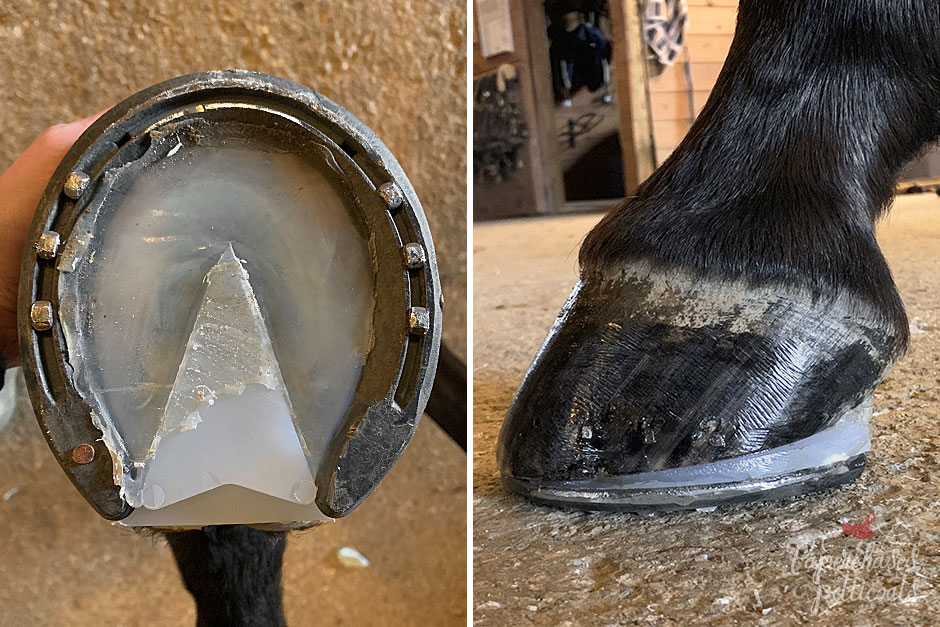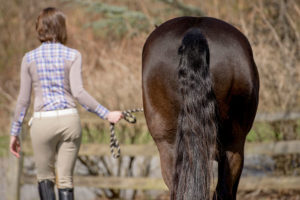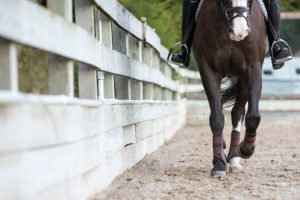You’ve likely heard the proverbial saying “no hoof, no horse.” This particularly rang true for me while treating and rehabilitating an injury to Dexter’s foot. The damage to his soft tissue structures caused a great deal of pain and lameness. To help provide more comfort throughout the healing process, therapeutic shoeing was introduced.
Therapeutic shoeing approach for deep digital flexor tendon injury
After identifying the exact location of soreness in Dexter’s foot based on MRIs, my farrier and veterinarian worked as a team to select a therapeutic shoeing approach which included:
Pressure distribution
My farrier used wedge pads to shift the forces upon Dexter’s feet from landing toe first to heel first. By employing a Myron McLane heel wedge (which raises the heel and provides support to the frog), he was able to decrease the strain to the deep digital flexor tendon.
Promoting breakover
Another way my farrier helped to create a normal heel first landing was by shortening Dexter’s toes and adding a boxy shape to build breakover into his shoes.
Shock absorption
Since Dexter was particularly sore in the sole of his foot, my farrier used Vettec Equi-Pak (pour-in pads) in both front feet under the wedge pads to distribute load and absorb concussion. Bonus–the Equi-Pak does not allow moisture to reach the sole, so thrush was never an issue!
The long-term effect of therapeutic shoeing on Dexter
Therapeutic shoeing noticeably helped Dexter transition more comfortably back to work.
It goes without saying, but none of the therapeutic shoeing approaches recommended by my farrier and vet would have been successful if A) Dexter’s feet had not been trimmed and balanced appropriately and B) the ground conditions and controlled exercise status were not considered. My farrier came out every 4-5 weeks in order to make changes gradually.
Here are some of the other setups we tried until we found the perfect match:
1. Saint Croix Eventer with rolled toe for breakover and Vettec Equi-Pak for support.
2. Mustad Equilibrium with rolled toe and wide webbed toe. Set up with 2 degree wedge pad and snow cuffs to help keep snow balls from forming.
3. Mustad Equilibrium shoe with wedge pad and frog support and packed with Vettec Equi-Pak. This set up had the best results. After several shoeings we reverted back to a Saint Croix shoe in attempt to lighten Dexter’s gait a little.
The ultimate goal of therapeutic shoeing for Dexter was to facilitate rehabilitation of his soft tissue injury and return him to functional use. As he continues to improve, my farrier is slowly weaning him from these modifications to be back in ‘regular shoes’. This may not be what happens, but at the very least the objective is to get back to simple wedge style shoes.





Controlled Exercise After A Soft Tissue Injury: How I Brought My Horse Back To Work Safely | Paperchases & Petticoats
January 20, 2019 at 5:58 pm[…] and feet for swelling or heat daily. My farrier was also very involved in this process, discussing therapeutic shoeing options with my vet to protect and support Dexter’s damaged tissue during increased […]